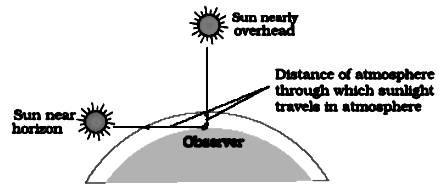
As sunlight travels through the earth’* atmosphere, it gets scattered (changes its direction) by the atmospheric particles. Light of shorter wavelengths is scattered much more than light of longer wavelengths. (The amount of scattering is inversely proportional to the fourth power of the wavelength. This is known as Rayleigh scattering). Hence, the bluish colour predominates in a clear sky, since blue has a shorter wavelength than red and is scattered much more strongly. In fact, violet gets scattered even more than blue, having a shorter wavelength. But since our eyes are more sensitive to blue than violet, we see the sky blue.
Large particles like dust and water droplets present in the atmosphere behave differently. The relevant quantity here is the relative size of the wavelength say, a). For a << λ, one has Rayleigh scattering which is proportional to 1/λ4. For a >> λ, i.e., large scattering objects (for example, raindrops, large dust or ice particles) this is not true; all wavelengths are scattered nearly equally. Thus, clouds which have droplets of water with a >> λ are generally white. At sunset or sunrise, the sun’* rays have to pass through a larger distance in the atmosphere (Fig.). Most of the blue and other shorter wavelengths are removed by scattering. The least scattered light reaching our eyes, therefore, the sun looks reddish. This explains the reddish appearance of the sun and full moon near the horizon.